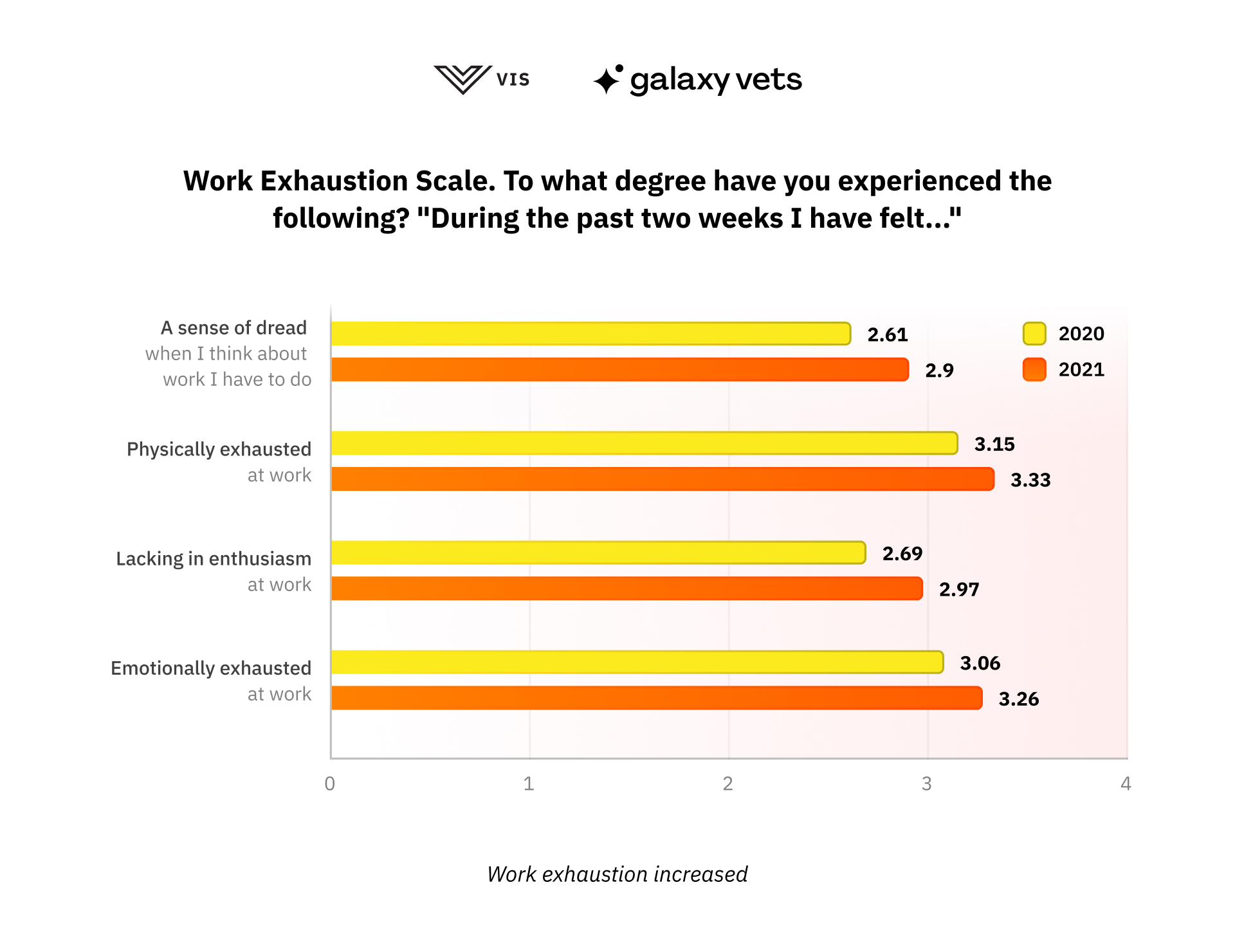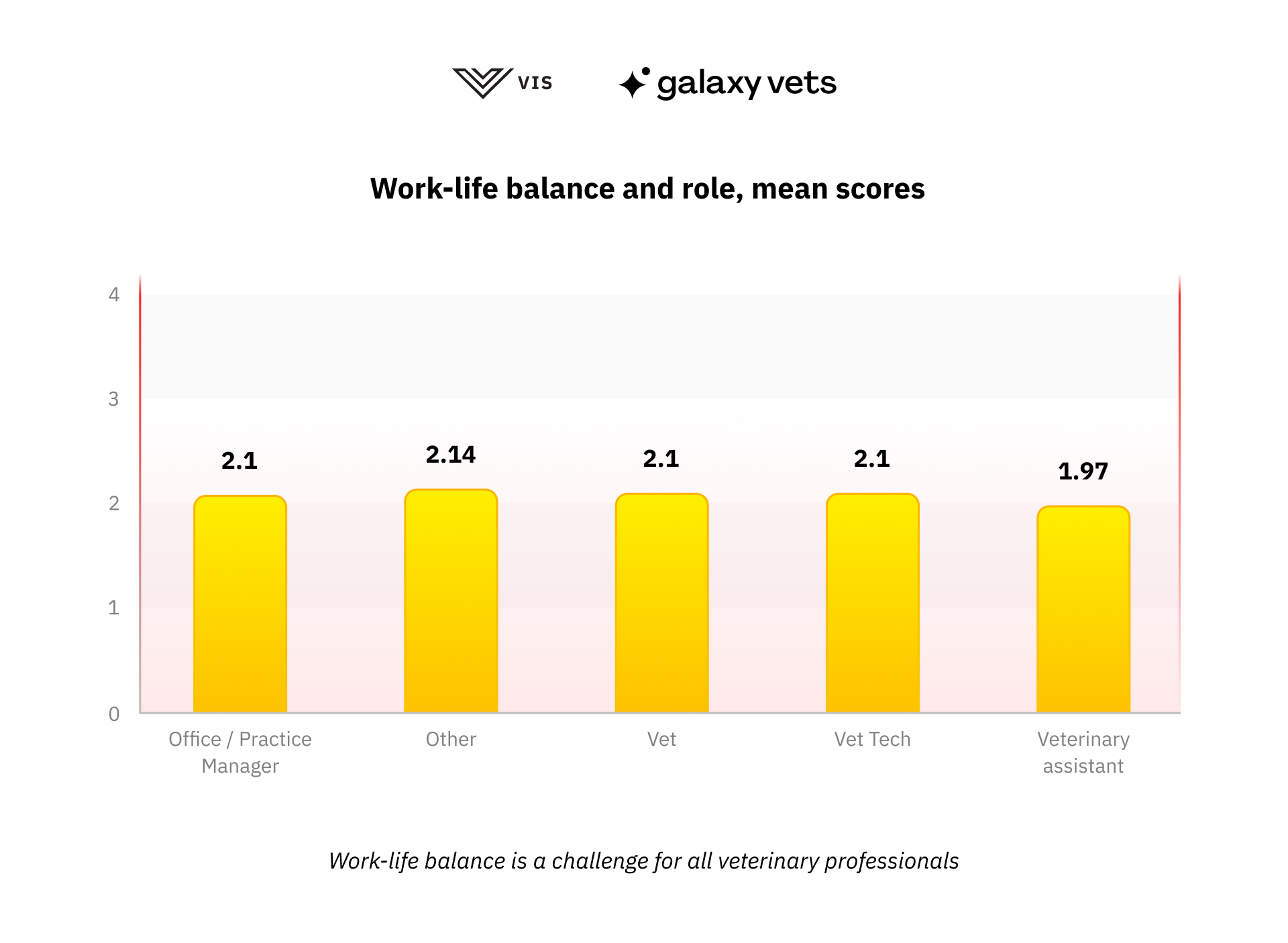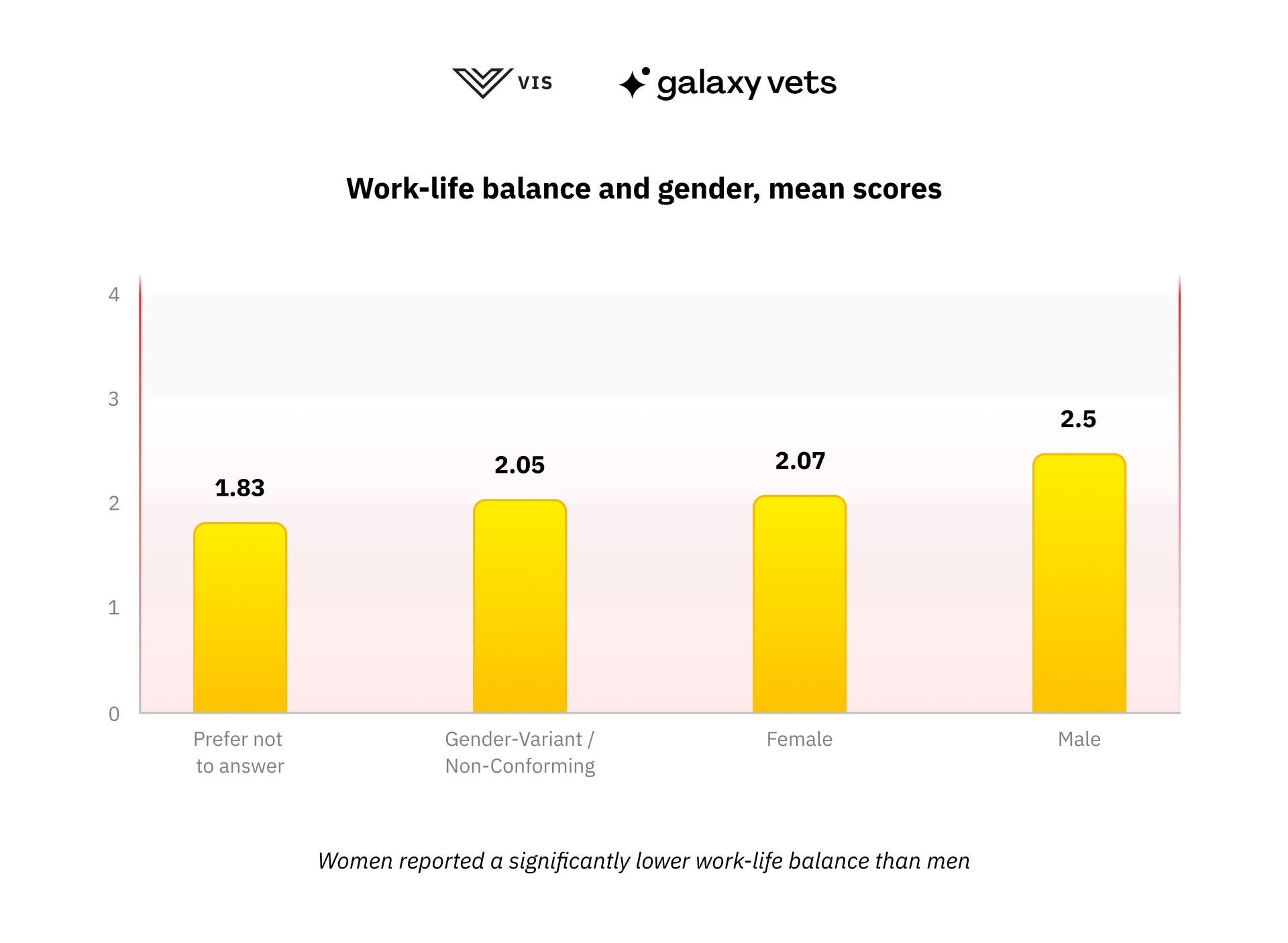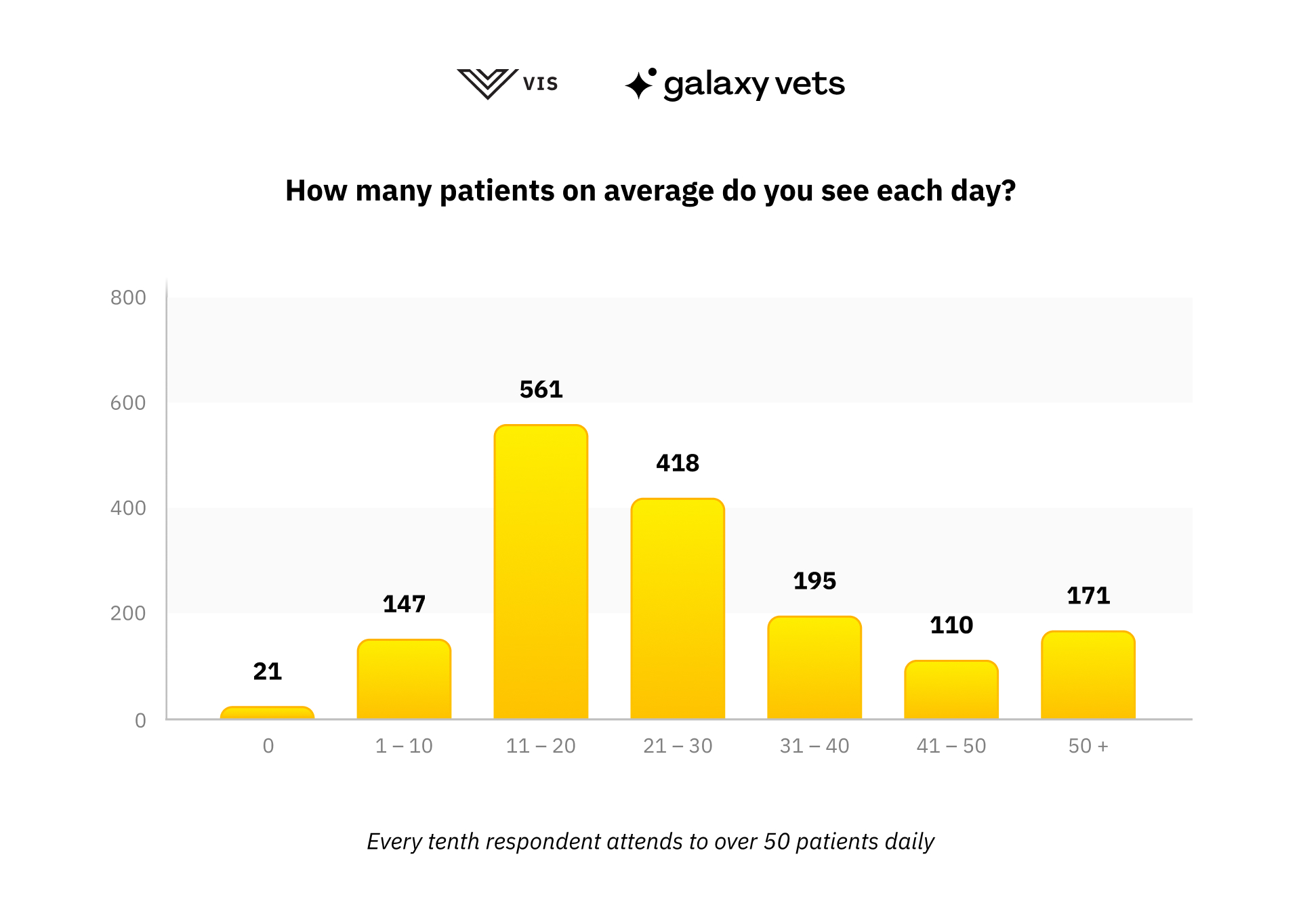“If your day doesn’t start until you get peed on, this is the place for you!”
— An intro message at the r/VetTech subreddit
Did you feel disgust, apathy, or alienation at your vet job at least once? These are the most common signs of professional burnout. Unfortunately, the problem is becoming more and more systemic for the global vet industry. In a nutshell:
- The burnout rate in the vet industry is steadily growing
- The most sensitive are younger staff members and women
- It is difficult for burned-out personnel to consistently deliver high-quality service
- As a result, professionals terminate their careers, vet businesses lose profitability, or even close, increasing the workload of the rest of the team, which accelerates burnout
There is much more. Galaxy Vets and VIS’ team have been delving deep into the veterinary burnout issue for the last couple of years. As a result, we’ve just released a 2021 edition of the Burnout and Work-Life Balance Study.
In the research, Dr. Ivan Zak and his team observed the problem across the board. Burnout investigation plays a major role in Dr. Zak’s scientific, business, and personal interests. Driven by the purpose to reduce burnout in the industry, Galaxy Vets is dedicated to creating its own thriving people-first culture and contributing to the development of the entire industry.
The article you’re reading isn’t just about the research. We’ll define the terms, deconstruct the issue into components and analyze them. We’ll also detail the first signs of imminent burnout and specify its stages. Finally, you’ll find many tips on how veterinary professionals can prevent burnout and lower job stress.
How burnout, compassion fatigue, and vicarious trauma are correlated
- Burnout is an answer to the chronic workplace stress that has not been successfully managed. It has several notable clinical signs.
- Compassion fatigue is another form of reaction to professional stress, resulting in emotional exhaustion and other symptoms.
- Therefore, vicarious trauma is more a theoretical condition resulting from repeated exposure to traumatic events. Compassion fatigue is an example of this type of reaction.
You may take into consideration that the definitions above are somewhat simplified. You can read our deeper thought on the topic in our article published in the VIS blog.
Components of burnout
As we said before, there are several typical components of burnout. Let’s review them.
- Emotional exhaustion
Emotional exhaustion is a feeling of moral depletion. This level of exhaustion may be different. It depends on both individual sensitivities to the repeating stress and the stage of burnout. For example, you feel absolutely no will and energy to perform even routine tasks and make simple decisions.

- Job detachment and cynicism
The detachment results in an increasingly hostile attitude toward your job. At the same time, you’re distancing yourself from the job.
- A feeling of hopelessness and performance decline
Hopelessness is a feeling that your effort does not affect anything. As a result, your performance declines and in the worst cases ceases completely.
- Physiological signs of burnout
All these psychological symptoms are coupled with different physiological ones. Resulting in decreased immunity; burnout causes frequent illnesses. Other physiological symptoms are stomach pains, insomnia, and headaches.
Three subtypes of burnout
There are three different subtypes of burnout that exist; their root causes are – frenetic, under-challenged, and neglect. All three were initially suggested by Barry Farber. And we should determine these subtypes before delving deeper into the issue.
Frenetic burnout
This subtype of burnout is caused by work overload. Working too hard usually ruins work-life balance and leads to problems in personal relationships. People affected by this subtype of burnout tend to work harder and harder to achieve their perfectionist goals. As a result, their workaholism impacts health.
Under-challenged burnout
For the veterinary staff feeling underappreciated leads to an under-challenged subtype of burnout. These people often feel a desire for better carer development and learning opportunities and are bored in the current situation. Under-challenged burnout usually results in job detachment and cynicism symptoms.
Neglect burnout
Some staff in the vet industry begin feeling incompetent when they’re doing their job. This is the most common for passive and reserved personalities. These feelings lead to the neglect subtype of burnout. Most often, it results in a feeling of hopelessness and a significant decline in performance.
You can find more detailed research on the topic in the article written by Dr. Lauren Catenacci.
Burnout research results and findings
Methodology and coverage
The survey conducted by Dr. Ivan Zak and Galaxy Vets team collected 1,623 responses. We used several approaches to the research:
- For the burnout rate and job satisfaction measuring – Brief Instrument to Assess Both Burnout and Professional Fulfillment in Physicians (PFI)
- For the work-life balance assessment – Psychometric Assessment of Fisher’s Instrument Designed to Measure Work-Life Balance
- We also included a separate set of questions for testing hypotheses in burnout prevention.
Key findings
The burnout rate is increasing
An average burnout rate has increased by 9.4% over the last year. This can be attributed to restrictions due to the pandemic, a deficit of vet staff, or an increasing number of clients coupled with longer appointment times.
Younger veterinarians remain the most burned-out
Like the previous year, younger vets are the most vulnerable to burnout. Other surveys, however, found that the vet students are graduating with a relatively low initial level of burnout.
We can explain it by a gap between their expectations and the real world of veterinary medicine. Also, during their education, students don’t learn critical soft skills, and after graduation, they experience their first work experience under strict pandemic restrictions. Student debt is indeed worsening the situation.
Vet technicians are the most affected roles
The result is the same as it was in the previous survey. The most plausible reasons are low pay, underutilization of skills gained during education, and lack of emotional reward. As a result, people are suffering from frenetic (due to long working hours), under challenge (due to rather monotonous work), or neglect (due to a lack of appreciation) subtypes of burnout.

Women are significantly more burned-out
The most plausible explanation is that women have lower work-life balance compounded by other caregiving responsibilities. At the same time, the group who identified themselves as gender-variant/non-conforming reported the highest rate of burnout. This finding offers further potential for more in-depth research on how burnout is tied to diversity, equity, and inclusion in the workplace.

Greater caseload = higher burnout
For the majority of respondents, burnout starts when the caseload is higher than 30 patients per day. At the same time, about 10% of all respondents said that they see 50 or even more patients per day.

Lower work-life balance causes burnout
The study found a correlation between work-life balance and burnout rate. About two-thirds of respondents said they would like help to achieve better work-life balance. They most often consider options such as hiring additional staff, mandatory days off, limiting work hours, and other restrictive measures.
Recommend you:
Veterinary Practice Management 101
Veterinary Telemedicine: a Complete Guide
Best Veterinary Conferences for 2022
How Much Do Vets Make in Different U. S. States in 2022
Podcast Episode: How to Build an Organization Without Burnout
Podcast Episode: Good Vibes Only: Positive Psychology for Vets
Podcast Episode: Resilience and Burnout in Veterinary Medicine
…and our other posts!
Having a strategy means lowering burnout
Eighty-seven percent of respondents claimed that their employers have no burnout prevention strategy, while 13% showed a significantly lower burnout rate.
Professionals with clear goals felt happier and reported less burnout
Veterinary professionals are potentially at higher risk of the under-challenge subtype of burnout. And about three-fourths don’t set professional goals.

How to avoid or reduce burnout
There are some common tips on how to avoid or at least reduce burnout. If you’re interested in the topic, you can review the whitepaper of our research here.
Long hours compensation can lead to burnout
When a clinic pays extra money for extra working hours, it makes the fact of systematic long hours legit. As a result, people susceptible to frenetic burnout consider this normal. The obvious way to lower the burnout rate is to reconsider the compensation policy.
Part-time employment and flexible scheduling can be a solution
Letting people work fewer hours for lower compensation is what many of them actually want, according to the data from the AVMA.
Support parents better
According to the DVM360.com research, for most veterinarians, their parental responsibilities are constantly coming into conflict with their working duties. Parental care leave and other childcare benefits are costly, especially for younger staff-student debt. So, paid parental leave and additional perks for parents can potentially help prevent burnout.
Hire relief veterinarians and locums
Relief veterinarians and locums are a great way to balance workload when your staff is on vacation. This helps your clinic to avoid increasing the workload for the permanent staff members when someone is off.
Ask your staff to care for themselves
Do not promote heroism among your staff; they first must take care of themselves. Many of them, of course, cannot resist a call for help. And your duty here is to avoid situations where your staff must decide whether to sacrifice themselves or patients.
Communicate more
Talk with your staff as much as possible. Listen to their concerns, issues, and fears.
Sponsor team-building activities
If your staff members like to spend their off-duty hours together or have hobbies, find ways to encourage them. The best option is to support their activities in a way you can.
Watch our webinar
Watch our live webinar “Burnout And Work-Life Balance Study 2021: Practical Takeaways For Veterinary Practices” recorded on Fri, December 17th. Where Dr. Ivan Zak, Dr. Lauren Catenacci, Dr. Melanie Bowden, and Alyssa Mages discussed the findings from the study and talked about some strategies that individuals and organizations can apply to improve well-being.
Conclusion
As you can see, burnout is a serious and constantly increasing challenge for the veterinary industry. We at Galaxy Vets are dedicated to combating this issue and being a veterinary healthcare system with happy teams only.
Please apply here if you are interested in working at Galaxy Vets or partnering with us.
Please feel free to share your suggestions!

